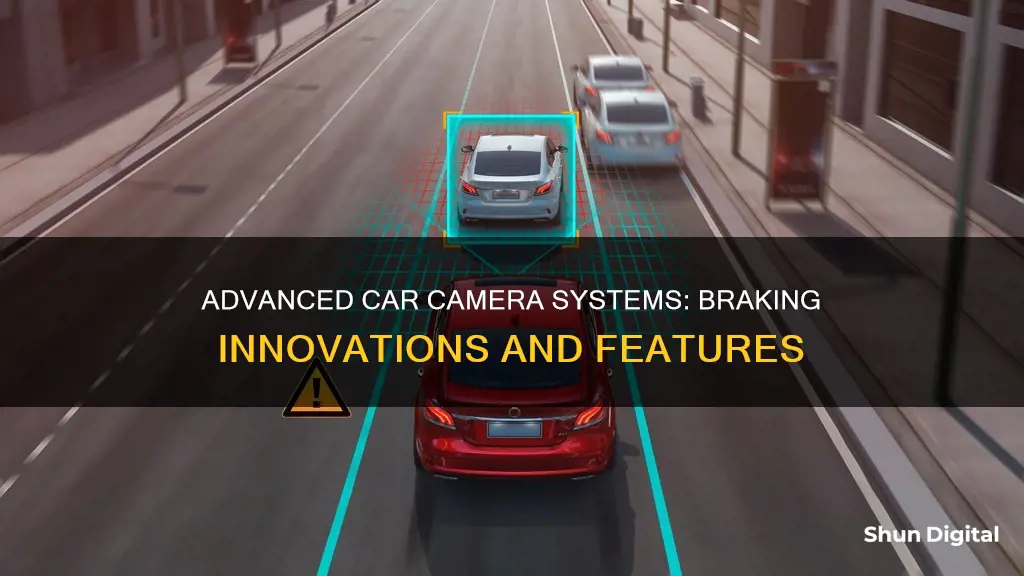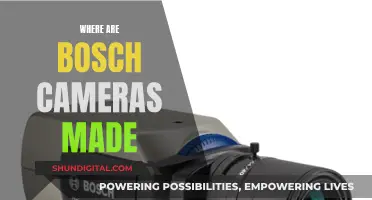
Many modern cars are equipped with advanced safety systems that can help prevent accidents and mitigate their impact. One such system is Automatic Emergency Braking (AEB), which uses sensors and cameras to detect when a collision is imminent and automatically applies the brakes if the driver has not already done so. AEB systems are designed to work in conjunction with other safety features such as Forward Collision Warning, which alerts the driver of a potential collision, and Pedestrian Detection, which can detect and avoid pedestrians and cyclists. These systems are proven to reduce accidents and save lives, with some studies showing a 15% reduction in crashes when AEB is combined with Forward Collision Warning. As a result, AEB is becoming increasingly standard across new vehicles, with many countries mandating its inclusion by a certain date.
| Characteristics | Values |
|---|---|
| Cars with braking systems that have built-in dashcams | Tesla, BMW, Mercedes-Benz, Toyota, Lexus, Mini, Subaru |
| Cars with automatic emergency braking systems | 2024 BMW 7 Series, 2024 Genesis G90, 2024 BMW X1, 2024 Kia Telluride, 2024 Honda Civic, 2024 Hyundai Palisade, 2024 Mercedes-Benz S-Class, 2024 Ford F-150, 2024 Audi A7, 2024 Rivian R1T, 2024 Chevrolet Corvette, 2024 Ford F-150 Lightning |
What You'll Learn

Automatic braking systems can save lives and reduce crashes
Automatic emergency braking (AEB) systems use sensors to detect when a vehicle is close to crashing into another vehicle or a pedestrian, and they automatically apply the brakes if the driver has not. AEB technology is also being developed to detect pedestrians in both daylight and at night. This technology has the potential to significantly reduce rear-end and pedestrian crashes.
The National Highway Traffic Safety Administration (NHTSA) in the US has finalized a new Federal Motor Vehicle Safety Standard that will make AEB standard on all passenger cars and light trucks by September 2029. NHTSA projects that this new standard will save at least 360 lives and prevent at least 24,000 injuries every year.
AEB is proven to save lives and reduce serious injuries from frontal crashes. The technology is now advanced enough to be required in all new cars and light trucks. AEB is also being developed to be more effective at higher speeds.
While AEB is a valuable safety feature, it does not replace the need for an attentive driver. It is important for drivers to remain alert and practice safe driving behaviours to prevent accidents.
Unleashing Camera Raw: Mastering the Art of Masking
You may want to see also

Forward collision warning systems reduce accidents
Forward collision warning systems are designed to reduce accidents by alerting the driver of an impending collision. These systems use sensors, radar, lasers, or cameras to detect the speed of the vehicle in front and the distance between the two vehicles. If the system detects that the vehicles are too close, it will warn the driver using lights, beeps, vibrations, or a combination of these alerts.
Forward collision warning systems are particularly useful when drivers are unable to respond quickly enough to a potential collision. In these situations, the system can provide a crucial warning, allowing the driver to brake or take evasive action to avoid a crash. This technology is especially effective in reducing frontal crashes into the rear of slower-moving or stopped vehicles.
Many vehicles with forward collision warning systems are now also equipped with automatic emergency braking. This feature further enhances safety by automatically applying the brakes if the driver fails to respond to the warning in time. While automatic emergency braking may not prevent every crash, it can help to lessen the severity of the impact.
Forward collision warning systems are recommended by the National Highway Traffic Safety Administration (NHTSA) as a safety technology. By helping to prevent crashes and reduce their severity, these systems have the potential to save thousands of lives each year.
Rental Cars and Dash Cams: Who's Watching?
You may want to see also

Backup cameras aid parking
Backup cameras, also known as rearview cameras, are now standard in all cars manufactured after 2018. These cameras are usually placed on the trunk lid or rear hatch, and they provide a live video feed to a central display screen, often the same one that handles infotainment functions. This setup gives drivers a much clearer and more accurate view of obstacles behind the car, making parking faster and safer.
Backup cameras also increase your peripheral vision, helping to eliminate blind spots. They often feature on-screen guidelines that help direct the driver into or out of parking spaces more easily. Some also have a middle line to assist with centering the vehicle in the parking space. Modern colour displays allow the system to change the colour of the guidelines from green to yellow to red as the vehicle gets closer to an obstruction. Many systems also include a warning tone to alert the driver when they are getting too close to an object.
Some backup camera systems are more advanced than others. For example, dynamic gridlines show the direction of travel, and 360-degree systems use multiple cameras to create a composite overhead view. Some vehicles also offer autonomous emergency braking, which automatically applies the brakes if the system detects a collision and the driver takes no action.
While backup cameras are a great tool to aid parking, it's important to remember that they are not a replacement for simply paying attention. They can help make parking easier, but they won't drive the car for you.
Focusing Film Cameras: Mastering the Art of Sharp Shots
You may want to see also

Lane-keeping assistance helps prevent unintentional lane drifting
Lane-keeping assistance is a safety feature that helps prevent unintentional lane drifting by monitoring the position of the vehicle relative to the lane boundary. This technology uses cameras, sensors, radar, GPS and lasers to determine if the vehicle is about to unintentionally move out of its lane. If so, the system activates and corrects the steering, brakes or acceleration, resulting in the vehicle returning to its intended lane of travel.
Lane-keeping assistance is particularly useful when driver error, such as fatigue, distraction or incapacitation, causes unintentional lane drifting. According to a 2014 Insurance Institute for Highway Safety (IIHS) research report, 40% of fatal crashes involved drivers who erroneously strayed from their lane. In all cases, lane-keeping devices could have helped avoid these fatalities.
Lane-keeping assistance is available in various cars, including the 2024 Kia Telluride, 2024 Mercedes-Benz S-Class, 2024 Chevrolet Corvette, and 2024 Ford F-150 Lightning. However, it is important to note that lane-keeping assistance is not a substitute for careful driving and paying attention when behind the wheel. The technology requires clear lane markings to be effective and can be overridden by the driver if needed.
Building a Camera Battery: Ion Basics and Beyond
You may want to see also

Automatic high beams improve safety
Automatic emergency braking systems are becoming increasingly popular, with many vehicles now including them as a standard feature. Automakers recognise the value of these systems, which can provide crucial assistance to drivers and improve safety on the road.
One such safety feature that is becoming more prevalent in modern cars is automatic high beams. This technology automatically switches a vehicle's headlights between low and high beams, depending on lighting conditions and traffic. This helps to improve safety by reducing the chances of dazzling other drivers with high beams and providing optimal visibility for the driver.
Automatic high beams use a forward-looking camera, typically mounted in the rearview mirror, to detect various forms of light, including headlights, tail lights, and ambient light from cities. When the camera senses oncoming headlights or tail lights getting closer, it automatically switches the high beams to low beams. Once the lights are no longer detected, the system turns the high beams back on.
This feature is particularly useful in rural areas with fewer street lights, as it eliminates the need for manual control of high beams, reducing the work and stress for drivers. Additionally, automatic high beams can improve safety by providing more light and increasing the driver's reaction time.
Some vehicles that offer automatic high beams as a standard or optional feature include the 2024 BMW X1, Audi A7, Chevrolet Corvette, and various Toyota models equipped with Toyota Safety Sense.
The Intricate Art of Crafting Camera Lenses
You may want to see also
Frequently asked questions
Automatic emergency braking (AEB) uses sensors like cameras and radar to detect when a vehicle is close to crashing and then automatically applies the brakes if the driver has not done so.
Many vehicles now include automatic emergency braking as a standard feature. Here are some examples:
- 2024 BMW 7 Series
- 2024 Genesis G90
- 2024 BMW X1
- 2024 Kia Telluride
- 2024 Honda Civic
- 2024 Hyundai Palisade
- 2024 Mercedes-Benz S-Class
- 2024 Ford F-150
- 2024 Audi A7
- 2024 Rivian R1T
- 2024 Chevrolet Corvette
- 2024 Ford F-150 Lightning
According to research by the Insurance Institute for Highway Safety, forward collision warning reduces accidents by 7 to 10%. When combined with automatic emergency braking, the number jumps to 15%.







